by Melanie Taylor | Mar 24, 2016

Use St. Patrick’s Day to learn about Irish culture in your 4-H club
I just discovered a few years ago that my great-grandmother, whom I never met, was an Irish redhead. I found this very exciting. It made me much more interested in learning about the history of St. Patrick’s Day, beyond wearing green. We live in a culture where we look for the next person or event to celebrate. For those who are Irish, St. Patrick’s Day is a time to reflect and celebrate their culture and traditions. So, although you may not be Irish, why not learn more about the Irish culture and why they are proud of their heritage? At your March 4-H club meetings, it would be fun to celebrate St. Patrick’s Day and incorporate the four-leaf clover and relate it back to the 4-H clover and what they both represent. Whether you are a 4-H leader or a teacher or parent looking for creative ideas, I hope you enjoy this brief history lesson and a few suggestions.
Let’s start from the beginning…
Who was St. Patrick? St. Patrick is the beloved patron saint of Ireland. The Irish are famous for spinning exaggerated tales. Despite the infamous stories traditionally attributed to St Patrick, this is what we actually known about his life. We do know that St. Patrick was born in Britain and that at the age of 16 was captured by Irish raiders who attacked his family’s estate. He was then transported to Ireland where he was held captive for six years, living a solitary, lonely life as a shepherd. It was then that he became a devout Christian, embracing his religion for solace. From his writing, we know that a voice, which he believed to be that of God, spoke to him in a dream, urging him to leave Ireland. He did. Walking nearly 200 miles, St. Patrick escaped to Britain and undertook serious religious training.
After 15 years of study, Patrick was ordained as a priest and sent to Ireland. His mission was to minister to Christians and to convert the Irish, then pre-dominantly pagans, to Christianity. Because St. Patrick was familiar with the Irish language and culture from his years of captivity, he chose to incorporate Irish ritual and symbols into his teachings rather than to eradicate Irish beliefs.
Why Do We Celebrate St. Patrick’s Day in America? The history of St. Patrick’s Day in America begins with Irish soldiers serving in the British army. The celebration’s focus is based on a tale of the Irish and evolving political power. The very first parade in New York City in 1762, not only helped the homesick Irish soldiers connect with their roots through the familiar strains of traditional Irish music, usually featuring bagpipes and drums, but also helped them to connect with one another, finding strength in numbers. Over the years as nearly a million Irish immigrants fled to America in the wake of the Great Potato Famine, St. Patrick’s Day parades became a display of solidarity and political strength as the often ridiculed Irish immigrants were frequently victims of prejudice. Soon enough, however, their numbers would be recognized and the Irish would organize and exert their political muscle, becoming known as the “green machine.”
Today, although less religious, St. Patrick’s Day celebrations continue to be a show of Irish strength and patriotism. So, put on your GREEN and get ready to celebrate!
4-H Club Meeting, Classroom, and Family Theme Ideas for March:
1) During a meeting or event read a “thought for the day” and use an Irish quote.
Example: May your blessings outnumber
The shamrocks that grow,
And may trouble avoid you
Wherever you go.
-An Irish Toast
2) Encourage the youth to wear green.
3) Provide or encourage youth to bring themed snacks to share, such as,
- Sliced fruit designed in shape of a rainbow, with vanilla wafers as the pot of gold, and yogurt fruit dip
- Rice Krispy treats colored with green food coloring and cut into four-leaf clover
- Green colored pudding or popsicles.
- Green fruit and vegetable trays (cucumbers, peppers, apples, grapes, kiwi).
4) “Make and Take” crafts, such as,
- Handprint four-leaf clovers with green paint on white paper
- Origami and/or construction paper four-leaf clovers.
5) Share these Fast Facts about Four-Leaf Clovers:
- There are approximately 10,000 three-leaf clovers for every “lucky” four-leaf clover.
- There are no clover plants that naturally produce four leaves, which is why four-leaf clovers are so rare.
- Today, four-leaf clovers are associated with St. Patrick’s Day, but they appear in centuries-old legends as symbols of good luck. The Druids (ancient Celtic priests) said they could see evil spirits coming and have a chance to escape in time. Four-leaf clovers were Celtic charms, presumed to offer magical protection and ward off bad luck. Children in the Middle Ages believed if they carried a four-leaf clover, they would be able to see fairies. The first literary reference to suggest their good fortune was made in 1620 by Sir John Melton.
- The leaves of four-leaf clovers are said to stand for faith, hope, love, and luck.
- It’s often said that Ireland is home to more four-leaf clovers than any other place, giving meaning to the phrase, “the luck of the Irish.”
If you have a passion for cultural heritage, consider becoming a 4-H volunteer. We need volunteers willing to share their rich cultural heritage with the next generation so that they can grow into a culturally competent workforce of tomorrow. For more information, contact your local UF/IFAS Extension Office or visit http://florida4h.org/volunteers.
by Jenny Savely | Feb 19, 2016

By 2050, the United Nations estimates that the total population will total around 9 billion people globally (United Nations: 2004). Meeting the challenge of addressing the needs of so many people is an opportunity for growth that can be gained through scientific developments and personal responsibility, areas in which 4-H eagerly works to educate youth and adults.
We learn that our everyday behaviors, even if they seem very small, can actually put a lot of strain on our environment when so many people do the same things.
We often ask our youth, “If everyone were to do the same things you do every day, what would that look like? What kind of impact do you think it would have?”.
We know that much of our daily energy use, like the amount of water we use, how much trash we produce, the kind of food we buy and where we buy it, and how much energy we use in our transportation, for example, can make a big difference if we all make decisions that keep our environment in mind.
We can help prevent environmental damage that leads to climate change and human illness by conserving energy and making a smaller ecological footprint. An ecological footprint is the amount of resources from the environment that are required to meet the demands of our everyday consumption of goods. 4-H encourages youth to make thoughtful decisions about their behaviors such as:
- Eating locally grown and in season produce
- Using reusable bags for shopping
- Buying products with less packaging and that are less processed
- Turning lights off when they aren’t in use
- Doing outdoor rather than indoor activities
- Walking, biking, carpooling, or taking public transportation
- Recycling
- Conserving water when brushing teeth and by displacing water in toilet tanks
- Only running washing machines with full loads
However, motivating people to change their behaviors can be difficult. In 4-H we work to encourage young people to understand at an early age the enormous impact they have on the health and well-being of others. The World Health Organization tells us that “…environmental factors are a root cause of a significant burden of death, disease and disability – particularly in developing (poor) countries. The resulting impacts are estimated to cause about 25% of death and disease globally, reaching nearly 35% in regions such as sub-Saharan Africa.” (World Health Organization: 2016). A good portion of environmental damage that affects us in negative ways is caused by our using more resources than our planet has the ability to renew at the same rate we use them and by extracting our resources in harmful ways. This may seem overwhelming, but there are actually very simple things that each of us can do that can significantly help lessen the impact. Actually, when we change our behavior is western countries like the United States, we can make more significant differences since we are one of the primary consumers of energy in the world.
And as always, youth learn not only by DOING but by helping to teach others! We encourage our youth to educate their friends and family as well as to mentor younger 4-H’ers in project areas like environmental science. If your youth or club is interested in learning more about energy conservation and environmental science projects, there are an array of wonderful resources, listed below, to help get you started. Your county 4-H agent is happy to help any youth or volunteer interested in this or any one of the project areas that help provide youth with research based education.
Games: http://www.energystar.gov/index.cfm?c=kids.kids_index
Curriculum: http://www.chesapeakebay.net/channel_files/18256/handout_-_4-h_environmental_curriculum.pdf
http://www.need.org/files/curriculum/guides/Saving%20Energy%20Student%20Guide.pdf
Resources for teachers: http://www.eia.gov/kids/energy.cfm?page=6
http://www.eia.gov/kids/energy.cfm?page=1
http://coseenow.net/antarctica/
United Nations. 2004. “World Population to 2300”. United Nations Department of Economic and Social Affairs: Population Division. United Nations: New York, NY.
World Health Organization: The Health and Environment Linkages Initiative (HELI). 2016. “Environment and Health in Developing Countries”. URL http://www.who.int/heli/risks/ehindevcoun/en/index1.html. Accessed February 5, 2016.
Photo: Wake County, North Carolina 4-H. http://www.wakegov.com/humanservices/family/4h/traditional/Pages/default.aspx
by pmdavis | Feb 5, 2016
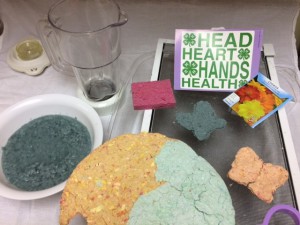
Grow Card Supplies and products
4-H literally got its start with gardening. The very first 4-H Clubs focused on growing tomatoes and corn for boys and canning for girls. Many youth and volunteers still enjoy gardening projects today. One great curricula that is used is the Junior Master Gardening Program. This program allows youth to enhance their life using gardening as the spark of interest. Gardening enriches youth’s lives, promotes good health, gives a sense of environmental awareness and saves money.
One of the activities I enjoy doing with youth combines gardening with recycling and crafting. As a group we will make our own paper grow cards or ornaments that have seeds embedded in them. Once the cards are dry, we deliver them as a service project. The cards are fun and inexpensive to make and are a perfect activity for your next club meeting! Try making them as valentines for Valentines Day. For beginners, we recommend growing tomatoes, lettuce, peppers, cucumbers, basil, chives, or parsley. Not into vegies? Try starting marigolds, cosmos, sunflowers, zinnias, pansies, or petunias.
Download our detailed factsheet with photos and directions. This activity is great for any occasion when you need a card or small gift. You can use as party favors by making them into ornaments using raffia to hang them from a tree or gift bag. You can take them to a nursing home, veterans center, hospital or other site as a service project for your club. Just be sure to share with the individual that they need to plant your card or ornament. It is a great way to help youth share their joy of gardening with others.
Other Extension gardening resources include:
• Florida Vegetable Gardening Guide
If you have a green thumb, consider going “totally green” as a 4-H gardening volunteer! 4-H needs caring adults like you to share their knowledge and passion for gardening with the next generation. Through the 4-H gardening project, youth not only learn gardening knowledge and skills, they also learn responsibility, teamwork, and other life skills that will help them grow up to be compassionate and competent citizens. To get involved, contact your local UF IFAS Extension Office, or visit Florida 4-H.
by Jena Gilmore | Jan 29, 2016
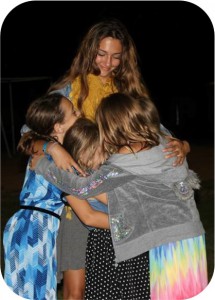
Teen retreat participants can earn credits towards their camp counselor certification.
Each summer Florida 4-H camps are bustling with 4-H volunteers, staff, and youth enjoying their week long residential camping experience. As a significant delivery mode in experiential learning, residential camping annually is home to nearly 4000 youth participants and 250 volunteers and agents. Within this mixture are some very important teens that give up their week as a “camper” and graduate to the role of “Counselors” or “Counselors-in-Training (CIT).” These teens, ages 13-18 sacrifice alone time, electronics, and sometimes their sanity in order to fulfill their leadership role at camp and place their campers needs ahead of their own. We’ve seen them overcome struggles, we’ve seen their growth, and we want to pay them back for all the countless hours they have dedicated to the program!
Therefore, the 2016 4-H Teen Retreat is scheduled for February 19th-21st at Camp Cherry Lake for ages 13 to 18! This is no ordinary camping experience for Counselor and CIT age teens. There will be no responsibility of campers but definitely the responsibility of having fun while teambuilding with other teens across the Northwest District. In doing so, teens will participate in workshops, fun-shops, listen to a key note speaker to inspire the leader within them, and then finish up the weekend with dancing, fun activities, and more. All camp rules and dress codes apply for the weekend. This fun-packed weekend costs $90 (scholarships may be available) and you can send payment and registration forms to your local 4-H Agent at the county Extension Office. This program would not be possible without the generous support of Farm Credit of Northwest Florida. Teen Retreat is just one of the ways that Farm Credit is helping 4-H grow future leaders. 
Furthermore, within the 4-H Teen Retreat mini camping experience, teens will have the opportunity to discover the spark within themselves, ignite that spark, and see personal growth with the guidance of 4-H through activities that foster Leadership, Confidence, Compassion, Curiosity, and Creativity. Teens will gain leadership skills and confidence in their abilities as leaders and productive members of their community through workshops focusing on teamwork and personal goal setting. Next, teens will experience growth in compassion as they work together to complete a service project by contributing to “Sole Hope,” an organization that helps place closed toed shoes on the feet of children in third world countries. Lastly, teens will express and grow their curiosity and creativity in “fun-shops” offering projects in photography, videography, nine-square, and para cord bracelet making.
Teens that participate in the 4-H Teen Retreat will leave camp with an arsenal of leadership skills, problem solving strategies, community service ideas and much more to take back to their counties. Teens may also expand their leadership potential by participating in some of UF/IFAS 4-H Priority Programs such as community clubs by becoming an officer or enhancing their current position; participation in citizenship and leadership through 4-H Legislature (June 27-July 1) participation in county events and attending 4-H University (July 25-29th.) Below are links to the State Events page where youth can customize their 4-H experience and tailor participation in events to fit their own personal leadership goals.
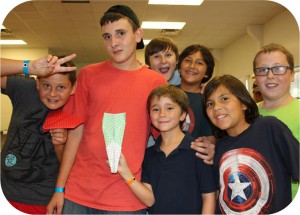 By participating in 4-H, youth are reported over twice as likely not to participate in risky behavior and are over 3 times more likely to contribute to their communities as compared to non-4Her’s (Florida 4-H: Facts & Impacts.) In the 2014 4-H Common Measures Statewide Survey of 4-H Seniors, 92% reported they know how to deal with stress in positive ways, 84% agree they learned things that helped them make a difference in their communities, 98% agreed they respect people from other cultures, and 95% agreed they can apply knowledge in ways that solve real-life problems through community service. These statistics show that through participating in 4-H activities and events, youth are becoming more competent, productive citizens in their communities. This in turn leads 4-H youth to be better prepared for leadership roles within the workplace.
By participating in 4-H, youth are reported over twice as likely not to participate in risky behavior and are over 3 times more likely to contribute to their communities as compared to non-4Her’s (Florida 4-H: Facts & Impacts.) In the 2014 4-H Common Measures Statewide Survey of 4-H Seniors, 92% reported they know how to deal with stress in positive ways, 84% agree they learned things that helped them make a difference in their communities, 98% agreed they respect people from other cultures, and 95% agreed they can apply knowledge in ways that solve real-life problems through community service. These statistics show that through participating in 4-H activities and events, youth are becoming more competent, productive citizens in their communities. This in turn leads 4-H youth to be better prepared for leadership roles within the workplace.
Take advantage of everything 4-H has to offer by kick-starting 2016 with the 4-H Teen Retreat! For more information on how to sign up for the 2016 4-H Teen Retreat contact your local 4-H Agent and complete the registration form below. For resources on leadership please visit these EDIS publications referenced in this article.
- Teen Retreat Registration & Medication Forms:
http://walton.ifas.ufl.edu/wp-content/uploads/2016/01/Teen-Retreat-Registration_Fillable.pdf
http://walton.ifas.ufl.edu/wp-content/uploads/2016/01/Medication_Form.pdf
- Florida 4-H Camping Facts & Impacts:
http://florida4h.org/camps/files/4-H_Facts_and_Impacts-Camps.pdf
- Florida 4-H Facts & Impacts:
http://florida4h.org/about1/impact/4-H_Facts_and_Impacts.pdf
- 4-H Common Measures Statewide Survey:
http://florida4h.org/about1/impact/4-H_Statewide_Survey_of_Seniors.pdf
by Julie Pigott Dillard | Jan 15, 2016
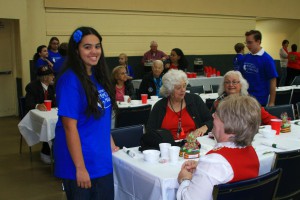
Fire Ants 4-H Club members prepare and serve meals for hospice patients and caregivers to develop compassion and empathy in their community.
There are many genetic traits you’re born with that can’t be changed. But what about traits such as compassion and empathy? Can they be learned? A new study conducted by the University of Wisconsin-Madison shows that adults can indeed be trained to be more compassionate and empathetic. But rather than wait until adulthood to grow this trait, youth involved in 4-H have the opportunity to grow compassion beginning as early as five years old. Giving back has long been one of the essential elements of 4-H programs where youth are given the opportunity to practice service to others.
The Fire Ants 4-H Club is one such club in Washington County that gives its members a chance to practice compassion and giving through its service project with Covenant Hospice. For the past two years, the Fire Ants 4-H Club has partnered with Covenant Hospice to provide volunteer services for its clients.
It began with a few members and parents volunteering to make a meal for a client. Last year, club officers applied for a Florida 4-H Foundation Community Pride grant to grow their efforts with the purpose of providing healthy, home-cooked meals for Hospice clients. Members and parents spent a day preparing and cooking made-from-scratch meals and then portioning them into individual serving containers. Over 100 individual home-cooked meals were frozen and delivered to clients. Members have also served at the past three annual Covenant Hospice banquet that honors patients and caregivers.
Community service has the ability to become life changing not just for those receiving the service but especially for the youth involved. 4-H’ers are learning through hands-on experiences that they can make a difference and that their efforts are important. Getting involved in a cause or effort that matters to youth helps develop skills and experiences that carry over into adult life and cultivate a sense of compassion for the world in which they live. If we grow youth who are more compassionate and empathetic, what does that potentially mean for our world? We are more likely to have youth who are socially responsible, who have a heart for giving back and helping others, who have positive relationships with peers and adults, who have improved communication and critical thinking skills and go into careers that feed their passions and interests.
What will you do in 2016 to grow compassion?
For more information on 4-H clubs in your county, or if you’re an adult who wants to work with youth to help them grow compassion and empathy to make help your community thrive, contact your local UF IFAS County Extension Office or visit http://florida4h.org.
by Jenny Savely | Dec 19, 2015
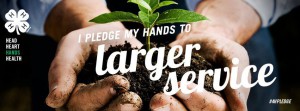
Clear evidence of mastering a skill is being able to employ it in one’s everyday life. Knowledge is only as good as how we are able to use it. 4-H dedicates itself to educating youth with research based curriculum not only for their own benefit but also so they can share that knowledge with others. When we “pledge our hands to larger service”, this can take on many forms. It may look like teaching youth in a community center about robotics or gardening, making meals for the military and first responders, or cleaning up trash in local parks. In all our service, it is important that regardless of what this looks like that we focus on meeting a need in our community. Identifying these needs is sometimes difficult if they are not part of what we see around us regularly. Talking to people who do not have the same life experiences we do is a good way to start seeing the world in a different way and thinking about ways you can help others who haven’t had the same opportunities. In Escambia County, around 30% of our youth population lives in poverty (US Census). Outcomes of living in poverty are hunger, poor housing, poor health, and lower educational scores, just to name a few. Our 4-Hers are learning to use the skills they have gained in 4-H in creative ways to help address some of these issues. One club has received a grant to raise a hog that a youth will show and have processed so the meat can be included in food boxes for local families. Another club raised funds to help support the Council on Aging to provide air conditioning units to the elderly, who are more likely to be impoverished, during the hot summer months.
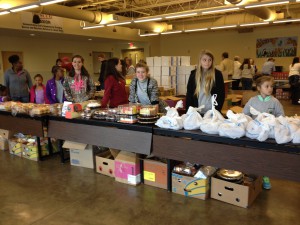
Escambia County 4-Hers assemble food boxes for local families at this year’s Farm to City event.
Whether poverty, pollution, safety, education, healthcare, or another issue is one that effects your community, the skills youth learn through 4-H can help address it. Not only does this help those around us live healthier and more productive lives, but it helps those who serve connect to their community and learn to give back. As with all 4-H projects, our goal is to help youth become more engaged and knowledgeable citizens that contribute to their world in positive ways. We encourage our youth to embody the spirit of generosity all year long, but during this season, be sure to explore the needs in your community you can help to change, even in the smallest way. If you need help thinking of how to best give back, contact your local 4-H Agent, local non-profits, or look up your county’s information in a database such as the US Census’ QuickFacts (http://quickfacts.census.gov/qfd/states/12000.html) and think about what kinds of problems might arise from the information you find there.
4-H also offers many Leadership and Citizenship projects that can help youth navigate assessing the needs of their community and putting their skills to use. You can find a few such project guides at the following links:
If you are interested in helping guide the next generation to be compassionate, active citizens for tomorrow, consider becoming a 4-H Volunteer. 4-H offers a wide variety of roles to fit your interests and schedule. Visit http://florida4h.org or contact your local UF IFAS Extension Office.
US Census. 2015. American Community Survey 2009-2013 five-year estimates, Children Characteristics: Escambia County, FL. Accessed November 18, 2015.









